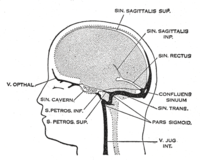
Photo from wikipedia
Background and Purpose— Cerebral vein thrombosis (CVT) is a type of venous thromboembolism. Whether the risk of pulmonary embolism (PE) after CVT is similar to the risk after deep venous… Click to show full abstract
Background and Purpose— Cerebral vein thrombosis (CVT) is a type of venous thromboembolism. Whether the risk of pulmonary embolism (PE) after CVT is similar to the risk after deep venous thrombosis (DVT) is unknown. Methods— We performed a retrospective cohort study using administrative data from all emergency department visits and hospitalizations in California, New York, and Florida from 2005 to 2013. We identified patients with CVT or DVT and the outcome of PE using previously validated International Classification of Diseases, Ninth Revision, Clinical Modification codes. Kaplan–Meier survival statistics and Cox proportional hazards models were used to compare the risk of PE after CVT versus PE after DVT. Results— We identified 4754 patients with CVT and 241 276 with DVT. During a mean follow-up of 3.4 (±2.4) years, 138 patients with CVT and 23 063 with DVT developed PE. CVT patients were younger, more often female, and had fewer risk factors for thromboembolism than patients with DVT. During the index hospitalization, the rate of PE was 1.4% (95% confidence interval [CI], 1.1%–1.8%) in patients with CVT and 6.6% (95% CI, 6.5%–6.7%) in patients with DVT. By 5 years, the cumulative rate of PE after CVT was 3.4% (95% CI, 2.9%–4.0%) compared with 10.9% (95% CI, 10.8%–11.0%; P<0.001) after DVT. CVT was associated with a lower adjusted hazard of PE than DVT (hazard ratio, 0.26; 95% CI, 0.22–0.31). Conclusion— The risk of PE after CVT was significantly lower than the risk after DVT. Among patients with CVT, the greatest risk for PE was during the index hospitalization.
Journal Title: Stroke
Year Published: 2017
Link to full text (if available)
Share on Social Media: Sign Up to like & get
recommendations!